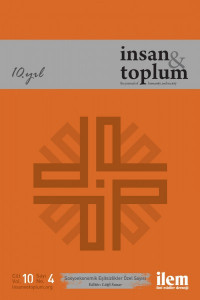Abstract
2020 yılının baharı, birçok yerleşik düşünce sistemini derinden sarsacağı umuğlan yeni bir hayata kapılarını araladı. Covid19- virüsünün salgın bir hastalığa dönüşmesi ile dünyanın birçok yerinde yaşam büyük ölçüde durdu ve klasik gidişat birçok sektörde olduğu gibi eğitim sektöründe de önemli değişimleri beraberinde getirdi. Ne var ki yerleşik sistemin alaşağı edileceği ve serbest piyasa ekonomisinin sonunun geleceği algısı bir yanda diri tutulurken bir yanda da eşitsizlikler belirginleşti ve eşitsizliğin acımasız yüzü, eğitimde fırsat eşitliği kavramını nasıl algılamamız gerektiği üzerinde eğitimcileri ve politika yapıcıları yeniden düşünmeye itti. 2020 yılı bahar döneminde Uluslararası İlişkiler bölümüne verdiğim Türk Siyasi Düşüncesi (Turkish Political Thought) adlı dersin vaka analizini yaparak bu konuya dikkat çekmeyi anlamlı buluyorum. Zira uzaktan eğitim verme serüvenim boyunca eşitsizliklerin öğrencilerin yalnızca performanslarına değil aynı zamanda motivasyonlarına da önemli etkisinin olduğunu gözlemledim. Bu çalışmada, uzaktan eğitimin farklılaşan yönlerine kısaca değindikten sonra sözü edilen eşitsizliğin boyutlarından bir nebze bahsedecek ve eğitimde fırsat eşitliğini yeniden düşünmemiz gerektiğini vurgulayacağım.
Keywords
References
- Brown, J. L. (2012). Online learning: A comparison of web-based and land-based courses. QuarterlynReview of Distance Education, 13(1), 39.
- Frey, F. W. (1965). The Turkish political elite. MIT Press.
- Gagne, M. ve Shepherd, M. (2001). Distance learning in accounting: A comparison between a distance and a traditional graduate accounting class. The Journal, 28(9), 58-60.
- Galusha, J. M. (1998). Barriers to learning in distance education. ERIC (Educational Resources Information Center). US Department of Education. https://files.eric.ed.gov/fulltext/ ED416377.pdf adresinden 11.06.2020 tarihinde erişilmiştir.
- Glenn, A. S. (2001). A comparison of distance learning and traditional learning environments. ERIC (Educational Resources Information Center). US Department of Education.
- Hannay, M. ve Newvine, T. (2006). Perceptions of distance learning: A comparison of online and traditional learning. Journal of Online Learning and Teaching, 2(1), 1-11.
- Kleinman, J. ve Entin, E. B. (2002). Comparison of in-class and distance-learning students’ performance and attitudes in an introductory computer science course. Journal of Computing Sciences in Colleges, 17(6), 206-219.
- Lockee, B. B., Burton, J. K. ve Cross, L. H. (1999). No comparison: Distance education finds a new use for ‘no significant difference’. Educational Technology Research and Development, 47(3), 33-42.
- Sahu, P. (2020). Closure of universities due to Coronavirus Disease 2019 (COVID-19): Impact on education and mental health of students and academic staff. Cureus, 12(4).
Abstract
References
- Brown, J. L. (2012). Online learning: A comparison of web-based and land-based courses. QuarterlynReview of Distance Education, 13(1), 39.
- Frey, F. W. (1965). The Turkish political elite. MIT Press.
- Gagne, M. ve Shepherd, M. (2001). Distance learning in accounting: A comparison between a distance and a traditional graduate accounting class. The Journal, 28(9), 58-60.
- Galusha, J. M. (1998). Barriers to learning in distance education. ERIC (Educational Resources Information Center). US Department of Education. https://files.eric.ed.gov/fulltext/ ED416377.pdf adresinden 11.06.2020 tarihinde erişilmiştir.
- Glenn, A. S. (2001). A comparison of distance learning and traditional learning environments. ERIC (Educational Resources Information Center). US Department of Education.
- Hannay, M. ve Newvine, T. (2006). Perceptions of distance learning: A comparison of online and traditional learning. Journal of Online Learning and Teaching, 2(1), 1-11.
- Kleinman, J. ve Entin, E. B. (2002). Comparison of in-class and distance-learning students’ performance and attitudes in an introductory computer science course. Journal of Computing Sciences in Colleges, 17(6), 206-219.
- Lockee, B. B., Burton, J. K. ve Cross, L. H. (1999). No comparison: Distance education finds a new use for ‘no significant difference’. Educational Technology Research and Development, 47(3), 33-42.
- Sahu, P. (2020). Closure of universities due to Coronavirus Disease 2019 (COVID-19): Impact on education and mental health of students and academic staff. Cureus, 12(4).
Details
| Primary Language | Turkish |
|---|---|
| Subjects | Other Fields of Education |
| Journal Section | Reviews |
| Authors | |
| Publication Date | December 15, 2020 |
| Published in Issue | Year 2020 Volume: 10 Issue: 4 |


